What Are NFT Games?
DEFINITION
NFT games are video games that use NFTs as a core part of their gameplay and economy.
NFTs are not a specialized technology anymore. Millions of consumers have had access to NFT technology over the last few years via Web3-native channels, social media sites like Reddit, and app stores exclusive to certain companies like Starbucks. In addition, a few of the biggest brands in gaming, like Square Enix and Ubisoft, are experimenting with NFT technology in order to learn more about its potential applications in video games.
What Are NFTs?
Non-fungible tokens (NFTs) are one-of-a-kind, one-of-a-kind tokens that are generated via blockchain technology and smart contracts. NFTs are always distinguished from other tokens on a blockchain by a unique identifier, unlike their fungible equivalents. An NFT is never the same twice.
There are several application cases in the fields of art, gaming, and finance as a result of this uniqueness and the sovereign digital ownership that blockchains provide, and the design area is just growing.
What Are NFT Games?
Video games that incorporate NFTs as a fundamental component are known as NFT games. NFTs are essentially blockchain tokens with distinct barcodes that can be given out by games and possessed by players in the context of gaming. Because NFTs can represent characters, objects (both complete and craftable), weapons, skins, and just about any other in-game asset that has the non-fungibility attribute, the design space for utilizing them in games is essentially endless.
But why even utilize NFTs in games?
NFT Games’ Advantages
NFT games are superior than their non-NFT counterparts in a number of ways.
Ownership by Sovereignty
Players don’t actually own their in-game goods, coins, or accomplishments in traditional games. These digital assets are exclusive to the game and cannot be utilized anywhere else because they are stored on a centralized server under the authority of game publishers, developers, and companies.
Players can own digital assets with NFTs in the same sovereign manner that they can own physical goods. They are theirs to possess, develop, and exchange whatever they see fit. Furthermore, as demonstrated by people’s propensity to collect tangible objects like rare coins, stamps, cards, and other memorabilia, true ownership of these kinds of artifacts fosters a new degree of player immersion and involvement. Because of the fleeting and unpredictable nature of any thing, it was impossible to create a digital collection prior to NFTs. The digital treasure may disappear at any time if the server that held it shut down.
The NFT will endure as long as the blockchain is operational. This gives the game experience a new depth and strengthens the bond between players and the digital goods and the systems that keep them up to date.
Cooperation
The shared underlying architecture of all NFT games created on the same blockchain connects them and allows for different types of permissionless interoperability between them. For example, an NFT from one game can be utilized in another game (or games) and have a different role within that game because NFTs can exist outside of the game from which they were obtained.
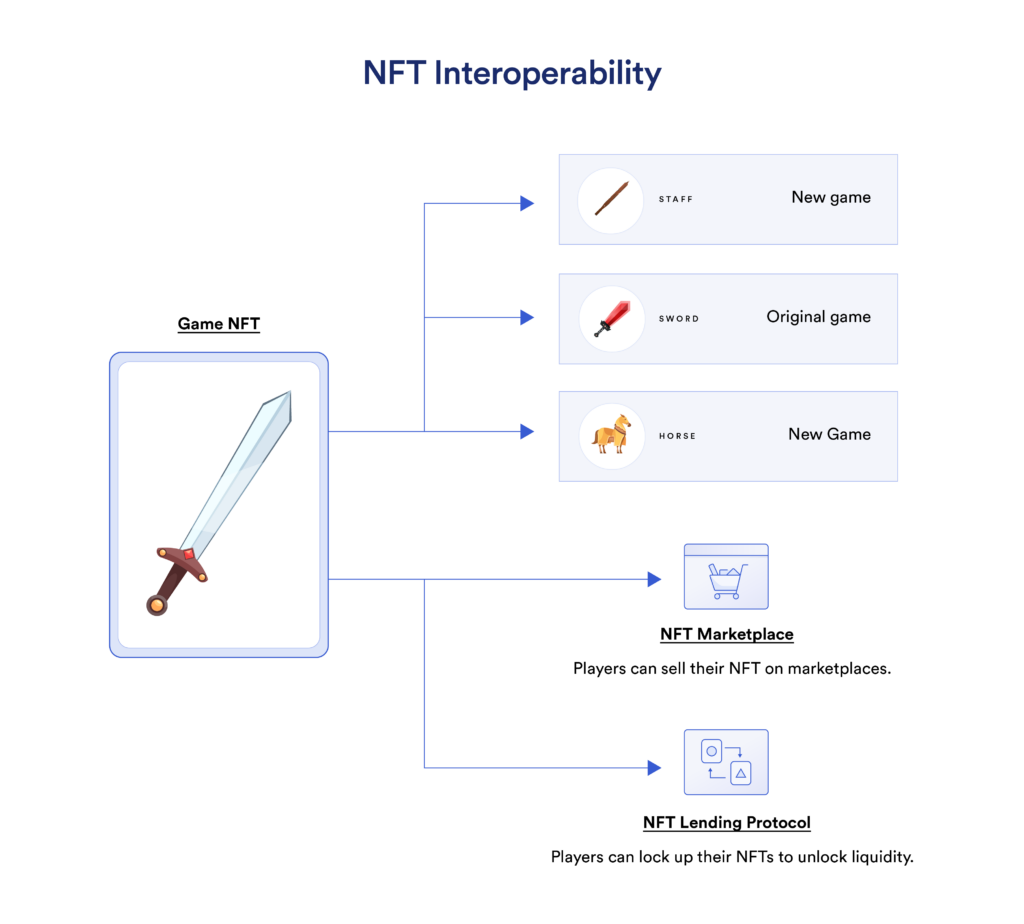
To encourage shared development that fully utilizes NFT interoperability, some Web3 initiatives have developed NFT primitives. This is achieved by first compiling a collection of NFTs, making them available, and then depending on NFT owners and enthusiasts to add to the NFTs by developing a range of games, experiences, and other components that make use of the NFTs.
Blockchains function as shared digital environments that are maintained by many and controlled by no one party in a world that is becoming more and more digital. Blockchain technology allows users to purchase NFTs, play various games, and borrow money from DeFi protocols against their NFT on a unified platform. The basis of every developing metaverse is this interconnected ecosystem’s intrinsic consistency, which enables users to navigate blockchain-based experiences in a peaceful and coherent way.
Revenue Generation
Every NFT is integrated into a broader, internal economy that is made up of all the other blockchain-based applications. In-game NFT purchases or rewards grant players instant access to public blockchain markets where they can freely exchange, buy, and sell NFTs. This opens up the prospect of earning real money while playing games, while it’s not a given that a player will make money.
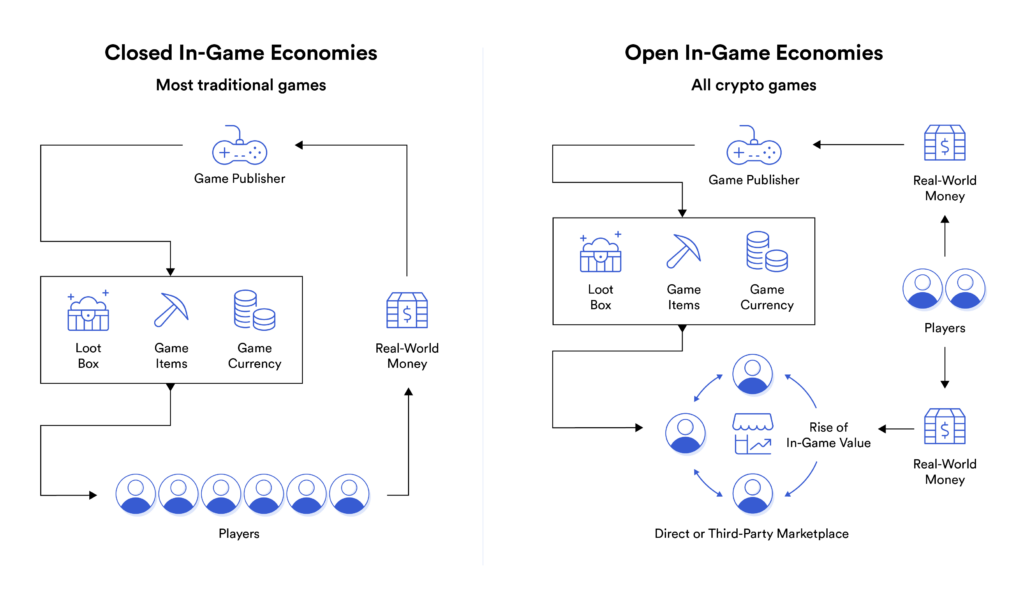
Additionally, this open economy opens up new revenue streams for NFT game producers. With this economic model, game producers are no longer forced to design for frequent and ongoing in-game purchases at the expense of the user experience. As an example, developers can receive royalties each time the NFTs they generated are exchanged on a marketplace.
Additionally, NFTs typically cost more than their conventional in-game item equivalents. In addition to having intrinsic advantages like permissionless operability, sovereign ownership, and access to free markets that many traditional games lack or are unable to provide, they are also more costly to manufacture, which raises the cost.
Examples of NFT Games
NFT games are available on a range these days. Some replicate the well-known thrills of classic games, boosted by the extra advantages indicated above. Some make the most of blockchain technology and try to build entirely new virtual worlds that are produced by enthusiasts working together.
Gods Freed
The gameplay of the NFT trading card game Gods Unchained is quite similar to that of online card games like Hearthstone and Legends of Runeterra, among others. In player-versus-player (PvP) games, players employ a deck of cards in an attempt to tactically outwit rivals and win.
In order to obtain cards, players must use the game’s local currency, which can be obtained via playing the game or by buying randomized packs of NFT cards. As NFTs, players immediately become the full owners of these cards upon receipt, and there is a native market where users are free to purchase and sell trading cards.
One NFT game that uses blockchain technology to improve a well-known gameplay paradigm is Gods Unchained. Players in video games such as Legends of Runeterra and Hearthstone do not totally control their cards. Gods Unchained keeps things digital while offering the advantages of real card games like Magic the Gathering and Yu-Gi-Oh!, where cards may be freely purchased, traded, and sold. This is made possible by the use of NFTs.
Dash Dookey
Dookey Dash was a time-limited NFT game with a distinctive take on the role of NFTs, developed by Yuga Labs, the same company that created the well-liked Bored Ape Yacht Club (BAYC) NFT collection. All BAYC NFT owners received access pass NFTs, which allowed them to enter the game. In order to play the game, players without a BAYC had to buy an NFT (limited-time access permit) on the public market.
The gameplay of the game itself was similar to endless runner games like Temple Run or Subway Surfer, where players competed to see who could get the greatest score on a leaderboard. At the conclusion of the competition, players who topped the scoreboard were awarded a range of NFT incentives that might come in handy later on in the BAYC world. Additionally, in-game powerups that improved gameplay were available for purchase by players.
Dookey Dash is an interesting case study of an NFT game that is part of a larger metaverse, with NFTs acting as both access and reward. While this model is likely difficult for more obscure games to replicate successfully, Dookey Dash showcased how NFTs can enhance gaming experiences, supercharge the role of status within game communities, and unlock latent demand for digital rewards.
Loot
Loot is not a typical NFT game. Rather, the project started out as a series of text-based NFTs without an image attached. Each NFT has a unique list of text that describes certain items, such as “Wool Sash,” “Linen Gloves,” and “Leather Boots of Enlightenment.”
As an experiment in collective world-building, Loot NFTs provided a primitive for creators, developers, and users to build on top of. Developers could pick and choose which items to build upon and how the items would manifest within different adventures, ranging from series of loot-based raiding games to puzzle-solving quests.
Loot represents a radically different take on what NFT games can look like. Rather than relying on a single game with a core gameplay loop, Loot NFTs introduced a primitive that unleashed the creativity of its wider community. Passionate enthusiasts and owners are collectively building out the lore, experiences, games, and other factors, all of which leverage the initial Loot NFTs.
Chainlink Services in NFT Games
There are a variety of technical restrictions and limits that blockchain games face, which is why access to secure and reliable Web3 services is crucial for NFT games to break into the mainstream. As the leading provider of Web3 oracle services, Chainlink offers NFT game developers the ability to fully harness the power of NFT and blockchain technology to create an end-to-end experience that can match, and enhance, existing games.
Chainlink Functions
The most pressing limitation facing any NFT game is the native inability of an NFT smart contract to interface with data outside the blockchain. This is important because most NFT games use smart contracts (which create the NFTs) alongside a traditional game server (to run core gameplay) due to blockchain scalability limitations. The more data available to NFTs, the more interactive the experience. Only with access to off-chain game data can developers create dynamic NFTs (dNFTs), which are NFTs that update dynamically based on external conditions.
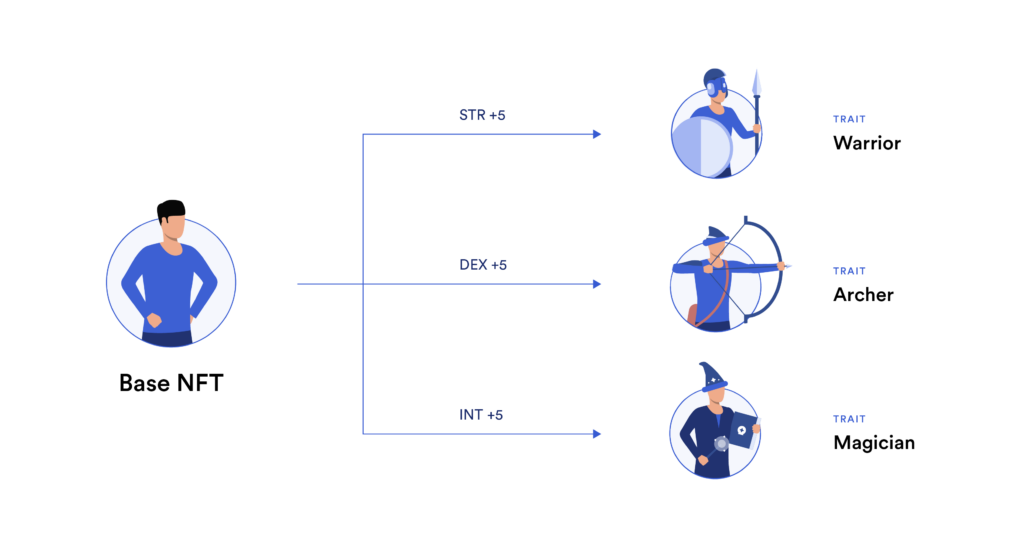
Game makers require a mechanism to swiftly and securely link off-chain data to their NFTs in order to build customizable weapons or role-playing characters with different skill levels. That is precisely what Web3 developers can do with Chainlink Functions, a serverless, self-serve development platform that lets them access any API. Developers can connect to any API in minutes with Functions, which speeds up the development of their games.
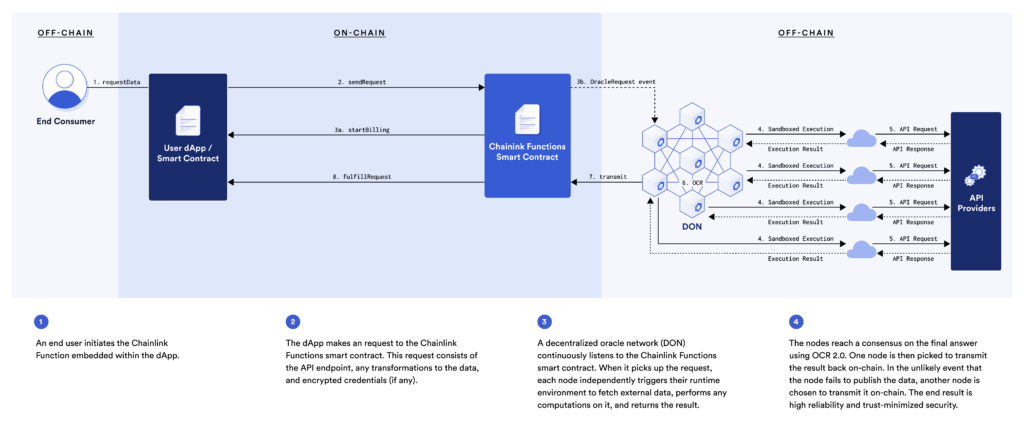
The Cross-Chain Interoperability Protocol
The Cross-Chain Interoperability Protocol (CCIP) is an oracle service currently in development that aims to solve the problem of blockchain-to-blockchain interoperability. While all applications on a blockchain can communicate with each other, applications that are built on different blockchains cannot.
This creates a problem for NFT games, which aim to target the largest player base possible. Users have a UX incentive to stay on one blockchain rather than traverse multiple. Thus, games must constantly expend resources to deploy from one blockchain to another—a solution that doesn’t scale as Web3 grows to support hundreds to thousands of blockchains.
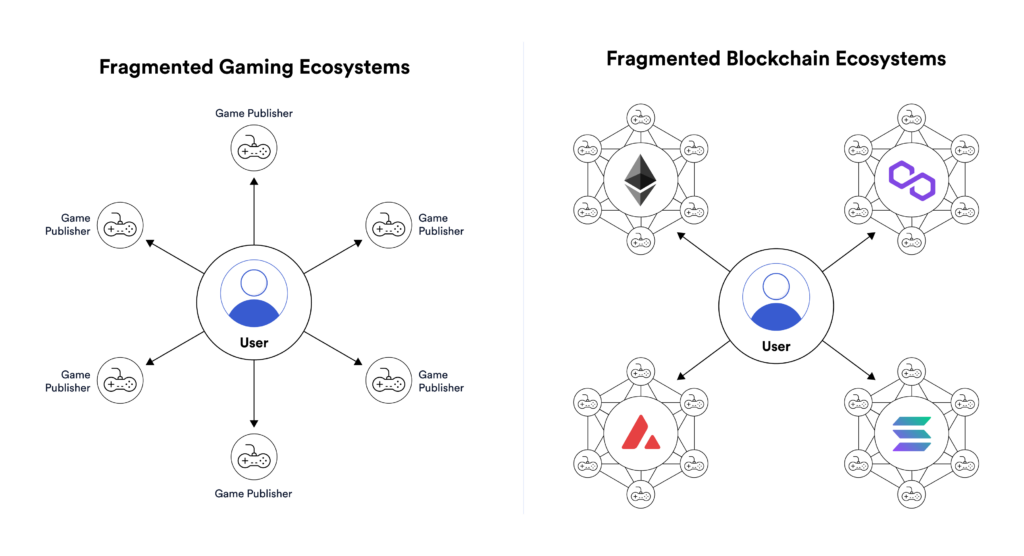
CCIP is designed to provide NFT game developers with the tools they need to build natively cross-chain applications. Not only does this unlock a seamless user experience, where eventually a single wallet can interface with all the world’s blockchains, but it also enables NFT games to optimize speed and cost across blockchains (i.e. the ability to choose to use different blockchains for different reasons).
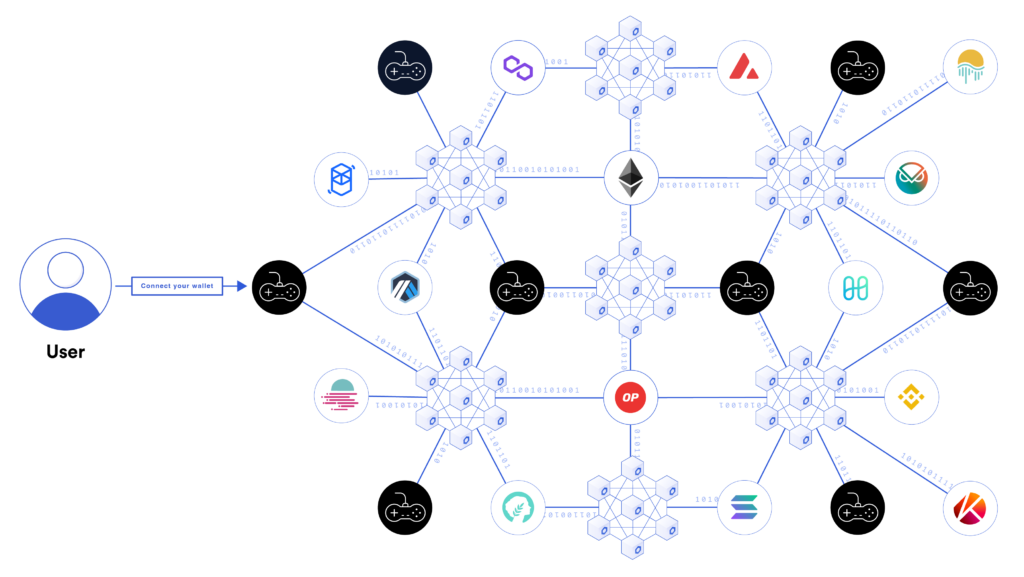
Chainlink Verifiable Random Function
Another limitation of NFT games is that blockchains don’t have a source of secure randomness. While traditional game servers can implement random number generators (RNGs) in black boxes to which nobody else has access, blockchains are inherently open and deterministic systems. Getting a true and fair random number that can’t be tampered with is a difficult task for game developers.
This limitation is particularly important for NFT distributions, which often use randomness for giveaways, airdrop allowlists, and more. Additionally, if players can predict the outcome of random game functions—such as map generation or critical hit strikes—it may give them an unfair advantage in the game.
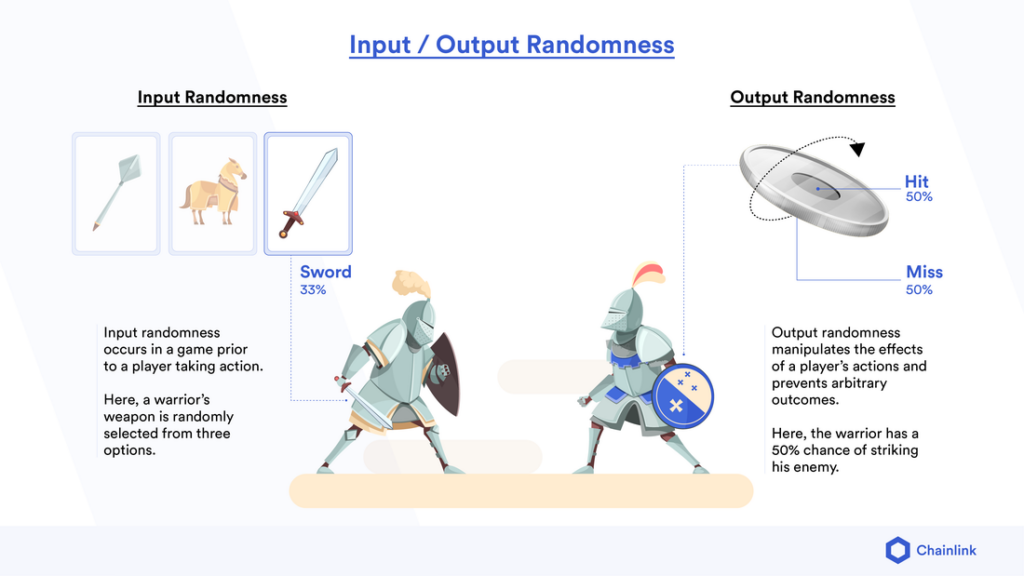
Any game must have fairness, and the best method to offer it is with the Chainlink Verifiable Random Function (VRF). With VRF, Web3 developers may easily obtain random integers that can be independently verified as being truly random by any user. Players may be assured of fairness and transparency in the outcomes of giveaways, raffles, allowlist distributions, and gameplay components using VRF’s distinctive Web3 assurance. In what other context is it possible to provide a mathematical guarantee of randomness?
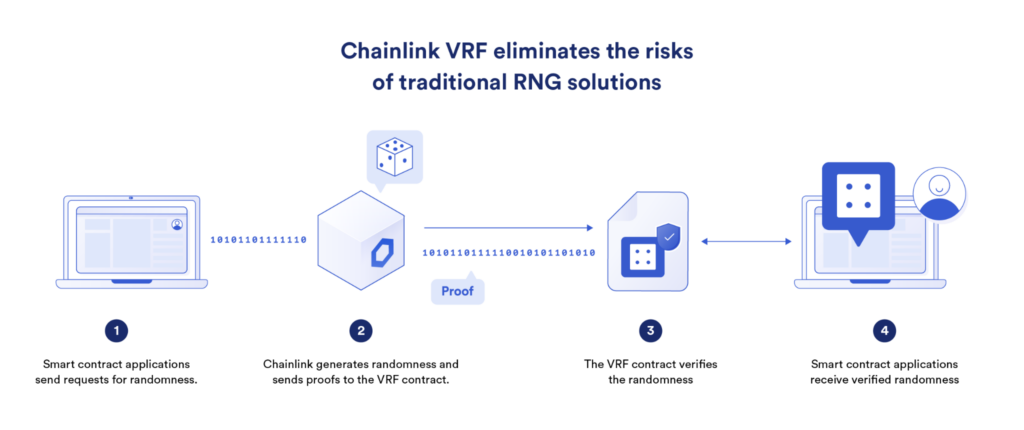
Conclusion
As an emerging vertical, NFT games have yet to realize their full potential, and it’s difficult to predict what NFT gaming will look like in the future as game developers experiment with different gameplay and monetization models. But there are limitless possibilities—for both players and developers alike—to build better, more engaging games on a foundation of sovereign ownership, permissionless interoperability, and experimental monetization.











